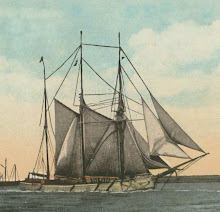Before the St. Lawrence Seaway opened, a type of ship, long familiar on the St. Lawrence River and in the Great Lakes was known as the "Canaller" and was the result of the difficult geographical features of the St. Lawrence River and the limitations of the canals built to overcome these difficulties. Canallers were divided into three main categories; bulk, package and special freighters.
The water route from the lakehead to the open sea is divided into three main parts; open water, navigation on the lakes themselves, river and canal navigation on the upper St. Lawrence River between Kingston and Montreal, and almost unrestricted navigation on the lower St. Lawrence and the Gulf. The upper St. Lawrence section is, of course, the portion most closely associated with the canaller and the part which has restricted free navigation
Although there were considerable improvements to the canals over the years, they still imposed many restrictions on design, and the "Canaller" was the result of the compromises made by these restrictions and the cargo-carrying requirements.
The canal locks on the three main sections of the St. Lawrence Canals varied slightly in dimensions, those of the Soulanges section being a little wider and longer than the Lachine and Cornwall - Lachine and Williamsburg sections. The controlling lock of the whole system, as far as ship dimensions are concerned, was No. 17 at Cornwall.
Canaller "ALGONQUINS tied up in the fourth Welland Canal
The maximum breadth of canallers was therefore strictly controlled by this lock and is generally 43 ft 7 in. extreme at the bilge.
The maximum over-all length was also fixed. The deck outline was arranged to give a reasonable clearance for the swing of the gates. The normal depth over the sills restricted the draft to 14 ft and most canallers are designed to operate at this draft when canalling.
"C.W.CADWELL in for repairs at Muir Bros. Dry Dock in Port Dalhousie, Ontario


